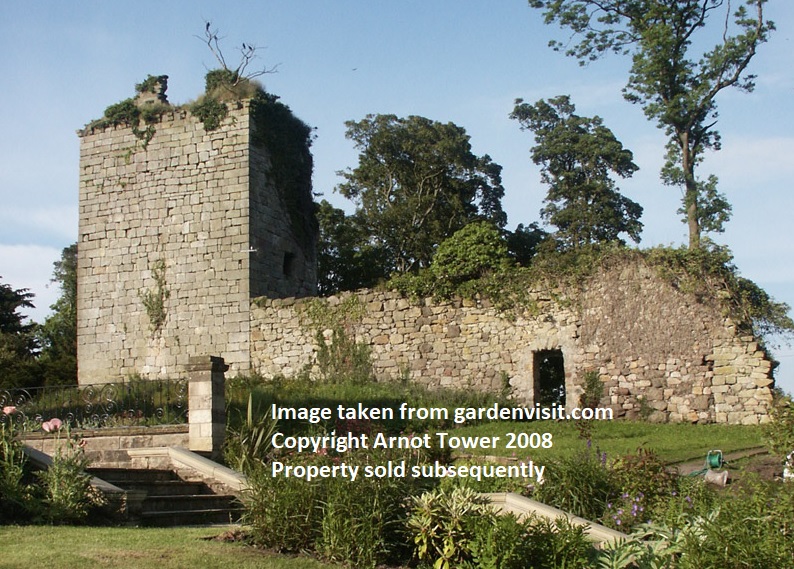Arnot Tower

Arnot Tower Details
Arnot Tower, ruined C16 tower within private grounds of C19 house. Gardens no longer seem to be open to public
- Access: No Access
- Grid Reference: NO207016
Arnot Tower is a ruined rectangular tower house dating perhaps to the late 15th century within the private garden grounds of the later mansion of Arnot Tower House. The tower is rectangular in plan (about ten metres by eight) and is four storeys tall, surviving to the wallhead in places, and it is accompanied by the remains of a walled courtyard to the south. The basement of the tower is vaulted, and was lit by a single slit window facing the courtyard. The entrance to the tower was in the south-east corner at ground floor level, and this corner of the tower is in fact entirely missing, suggesting that the stairwell serving all floors was probably in this corner, mostly enclosed within the nearly two metre thickness of the walls. Joist holes remain to confirm that the second floor and third floor were supported upon timber floors, and the window openings that survive are small in size. A centrally placed window at second and third floor level overlook the courtyard, but none face in any other direction – and curiously none can be seen to have lit the great hall from the outside, although they may well have been blocked up. An opening within the south-eastern wall seems to have been a garderobe serving the chambers of the third floor. There was a wallwalk which projected slightly from the walls upon machicolations, and an attic.
The lands of Arnot was held by a family who took their name from their estate as early as the 12th century, and the tower remained occupied by that family until it was eventually abandoned in the 18th century. It was first mentioned in 1507, and the design together with the ashlar masonry suggests a date in the second half of the 15th century for construction. The family held their lands from the Earl of Fife, and as a result were adherents of Edward Balliol rather than King David II in the mid 14th century, and later followed the faction of the Duke of Albany (presumably in his role as Earl of Fife), James de Arnot being recorded as his shield bearer in 1413. The family rarely played a part in affairs outside of Fife, although Robert Arnot repaid the grant of his lands in free barony by King James IV by dying alongside the king at Flodden in 1514. The castle itself does not appear to have played any military role, remaining the family seat, and the estate was eventually sold to the Bruce family in 1705 in order to cover the repayment of debts.
The ruin cannot be seen from the public road, and although the gardens of Arnot tower House used to be opened to the public occasionally, this does not seem to be the case any more.
Become a supporter of my work to access a more detailed history